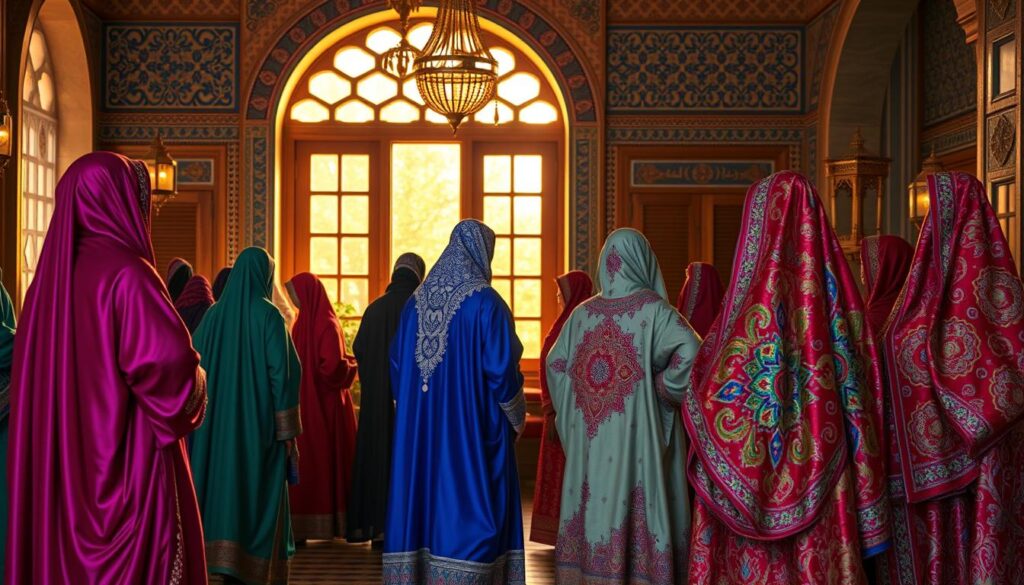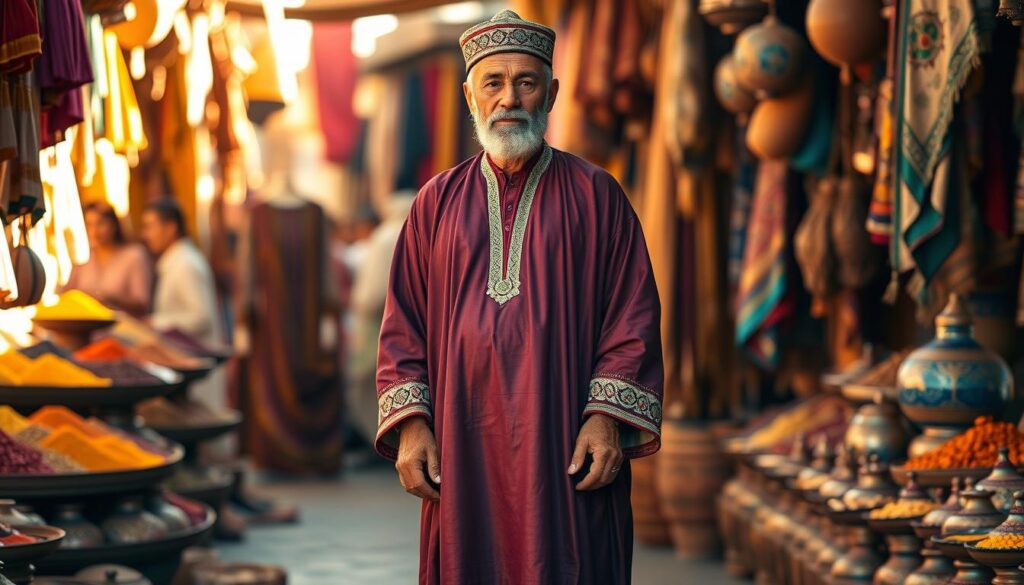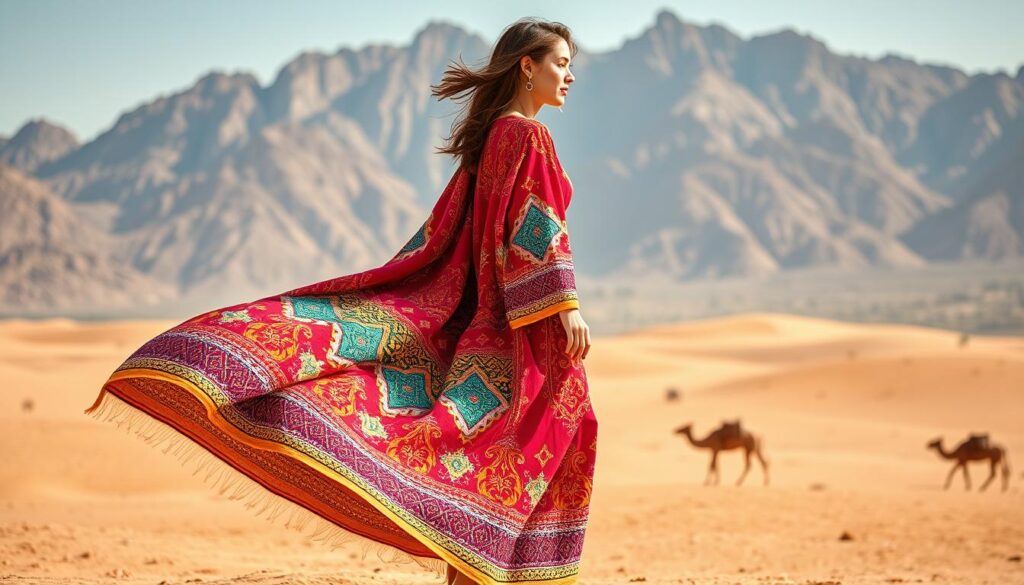Clothing is more than just a necessity; it’s a reflection of a culture’s identity. With cultural heritage being intricately woven into every thread, Moroccan clothing stands out as a vibrant representation of history and tradition.
The rich tapestry of Moroccan garments has evolved over centuries, influenced by various civilizations, including Berber, Arab, and Andalusian cultures. This blend of influences is evident in the intricate embroidery and vibrant fabrics used in traditional clothing.
Understanding the significance of these garments provides insight into the country’s values and history. As we explore the world of authentic Moroccan clothing, we uncover the stories behind the iconic djellaba, elegant kaftan, and other regional variations.
Key Takeaways
- Moroccan clothing is a rich tapestry of cultural heritage.
- Traditional garments reflect regional identity and social status.
- Intricate embroidery and vibrant fabrics are hallmarks of Moroccan clothing.
- Moroccan attire continues to be worn for daily life and special occasions.
- The cultural significance of traditional clothing is preserved through generations.
The Cultural Significance of Morocco Traditional Wear
Moroccan traditional wear is not just clothing; it’s a living museum of the country’s complex past. For centuries, Moroccans have worn traditional clothing that reflects their rich cultural heritage, with influences from various cultures such as the indigenous Berber tribes, Phoenicians, Arabs, and Romans.
The historical influences on Moroccan clothing are diverse and multifaceted. The country’s strategic location in North Africa made it a crossroads for various cultures, resulting in a unique blend of styles.
Historical Influences on Moroccan Clothing
The traditional Moroccan clothing is a testament to the country’s history, with indigenous Berber designs, Arab elegance, and Andalusian refinement being some of the key influences. The cultural exchanges that occurred over thousands of years across North Africa are reflected in the various garments.
- Moroccan clothing represents a living museum of the country’s complex history.
- The historical influences include indigenous Berber designs, Arab elegance, and subtle elements from trade with sub-Saharan Africa and Europe.
- Traditional garments have been part of Morocco’s cultural resistance to colonization.

The Role of Climate and Geography in Shaping Traditional Attire
The diverse climate conditions found throughout Morocco, from the snowy Atlas Mountains to the scorching Sahara Desert, have directly influenced the design of traditional attire. The geography of Morocco has resulted in regional clothing variations, with mountain dwellers favoring thick wool garments for warmth, while coastal regions developed lighter, breezier attire.
Climate considerations are evident in the design of Moroccan attire, with features like the pointed hood of the djellaba serving as protection from both sun and rain. This demonstrates the practical wisdom embedded in these traditional designs.
Traditional Moroccan Clothing for Men
The traditional clothing worn by men in Morocco is a testament to the country’s diverse history and geography. Moroccan men’s attire is not just about aesthetics; it’s deeply rooted in the country’s culture and influenced by its climate and regional variations.
The Djellaba: Morocco’s Iconic Male Garment
The Djellaba is a cornerstone of men’s traditional clothing in Morocco, characterized by its long, loose-fitting design with full sleeves and a distinctive pointed hood known as a “qob.” Originally made from thick wool for colder climates, modern Djellabas are also crafted from cotton for warmer weather, showcasing the adaptability of traditional garments.

Other Essential Men’s Attire: Qandrissi, Deraa, and Tarbouche
Besides the Djellaba, other essential components of traditional Moroccan men’s clothing include the Qandrissi trousers, known for their baggy design, which allows for ease of movement. The Deraa, a loose-fitting garment, is favored in the Sahara region for its ventilation properties. For special occasions, men often wear the Tarbouche (Fez), a cylindrical red hat adorned with a tassel, symbolizing Moroccan identity.
Traditional Footwear and Accessories for Moroccan Men
Traditional Moroccan men’s attire is complemented by specific footwear and accessories. Babouche (Balgha), heelless leather slippers, are worn on formal occasions, with yellow being a traditional color for men. Accessories such as leather belts, shoulder bags, and the Cheich (turban-like head covering) are used to protect against the elements and add to the overall traditional look.
Moroccan men’s traditional clothing is a rich tapestry of cultural heritage, practicality, and regional identity. From the iconic Djellaba to the elegant Tarbouche, each garment and accessory plays a significant role in defining Moroccan culture and tradition.
Women’s Morocco Traditional Wear
Moroccan women’s traditional clothing is a vibrant reflection of the country’s rich cultural heritage. The diverse and intricate designs that adorn these garments are not only aesthetically pleasing but also carry significant cultural and historical meaning.
The Kaftan: A Timeless Symbol
The kaftan stands as a quintessential symbol of Moroccan femininity, characterized by its single-piece, floor-length silhouette adorned with elaborate embroidery, sequins, and other decorative elements. For Moroccan women, the kaftan represents more than just clothing; it embodies cultural heritage, social status, and artistic expression. The designs and fabrics used vary based on the occasion, ranging from elegant everyday versions to opulent wedding kaftans.

The Takchita and Djellaba for Women
The takchita, a two-piece ensemble consisting of a dress with an ornate overdress, has evolved from royal court attire to become a beloved choice for Moroccan women attending weddings and special celebrations. Women’s djellabas, on the other hand, differ from men’s versions in their more fitted silhouettes, colorful fabrics, and intricate embroidery patterns, making them versatile garments for daily activities while maintaining modesty and style.
Regional Variations in Women’s Garments
Regional variations in women’s traditional clothing reflect Morocco’s diverse geography and cultural influences. The haik, a white wool or silk wrap, is predominant in northern regions, while the colorful melhfa is common among Sahrawi women in the south. The lightweight gandoura is preferred in warmer areas.
| Region | Traditional Garment | Description |
|---|---|---|
| Northern Morocco | Haik | A traditional white full-body dress made of silk and wool, covering the whole body except the face and hands. |
| Southern Morocco | Melhfa | A colorful garment commonly worn by Sahrawi women. |
| Warmer Areas | Gandoura | A lightweight garment preferred for its comfort in warm climates. |
The embroidery techniques used in women’s traditional garments often tell stories of regional identity, with distinct patterns and color schemes identifying the garment’s origin. Modern Moroccan women have adapted traditional designs to contemporary lifestyles, creating fusion styles that honor heritage while incorporating new fabrics, cuts, and styling approaches.
Conclusion: Preserving Morocco’s Textile Heritage in Modern Times
The enduring appeal of Moroccan traditional wear lies in its blend of practicality and cultural significance. Moroccan clothing has managed to thrive in the modern era, thanks to the efforts of artisans who continue to preserve ancient techniques while adapting to contemporary tastes and needs.
Moroccan traditional clothing is not just a reflection of the country’s rich history but also a symbol of national identity and cultural continuity. For special occasions like weddings and religious holidays, Moroccans of all ages continue to embrace traditional attire, demonstrating the significance of these garments in marking life’s important moments.
The global appreciation for Moroccan design has created economic opportunities for artisans specializing in traditional embroidery, leatherwork, and textile production. As a result, these crafts remain viable career paths, ensuring the preservation of Morocco’s textile heritage for future generations.
In conclusion, Moroccan traditional wear continues to play a vital role in the country’s culture and identity. Its unique blend of practicality, beauty, and cultural expression has allowed it to remain relevant through the years, connecting modern Moroccans with their rich and diverse heritage.